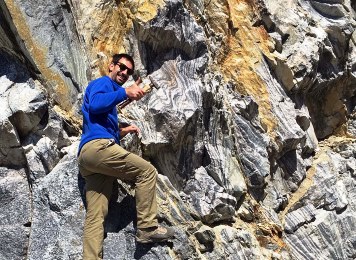08 June 2017
 To say UniSA’s Tom Raimondo is hoping for a rock revival would be an understatement.
To say UniSA’s Tom Raimondo is hoping for a rock revival would be an understatement.
As a convert to geology, Tom aims to use the opportunity of being named in ABC Radio National’s 2017 Top 5 researchers under 40 years old, to spread the word about the fascination and usefulness of geology, a science sometimes seen as an “oldie”, but one he believes is still very much a “goodie”.
In between studying the significance of hot rocks under the Antarctic ice sheets and scaling rock faces shaped by deep earthquakes in Norway, it is nothing for Dr Raimondo to share some “show and tell” at primary schools, hoping to get more kids interested in the environment through the wonders of geoscience.
“It is a bit of a tragedy that all the interest in fossils, dinosaurs, rocks and minerals that is really heightened in young kids, somehow dissipates in high school – geology just isn’t a key subject anymore,” Dr Raimondo says.
“There is also this stereotype that if you study geology you end up being in the mining industry, working a fly-in, fly-out lifestyle, in completely remote areas, to dig things out of the ground.
“But there is just so much more you can do, there are a range of different jobs out there for people with geoscientific skills, and much of what we are researching and learning about the geological evolution of the planet is extremely important for its future survival.”
One of his current projects is to explore the impact of hot rocks on the stability of the east Antarctic ice sheet.
Many rocks produce heat as part of the slow, natural breakdown of small minerals enriched in elements such as thorium (Th), uranium (U) and potassium (K).
Understanding at what point these rocks at the base of glaciers may affect the stability of the ice above is important because there may be a tipping point where the sheets are lubricated enough to accelerate their movement and become unstable.
“Dramatic instability of the largest ice sheet in east Antarctica has the potential to raise global sea level by 3.5 m if it were to completely melt,” Dr Raimondo says.
“Conducting this kind of research is never going to be easy because getting a measure of the temperature of the earth, represented by the hot rocks below, means having to drill down hundreds of metres into the subsurface – no mean feat in the Antarctic.
“To date it has only been achieved six times in this region. But here is where past scientists and our geological knowledge comes into play.
“Rocks brought back from the Antarctic by the famous South Australian explorer, Sir Douglas Mawson, on his first expedition in 1911, along with additional samples that have been brought back by other expeditions since this time, form a collection of thousands of specimens that we can use to measure their U, Th and K content and calculate how much heat energy they release.
“But as well as those samples, by looking back in time and reconstructing the jigsaw puzzle of the Earth’s tectonic plates, we know Australia and the Antarctic were once joined. So we have found that rocks in the Nullarbor share the same geological history as those in the Antarctic.
“Right now one of my PhD students, Alicia Pollett, is working on a drill rig on the Nullarbor Plain, running a very long thermometer down drill holes to take the temperature of the Earth.
“What we have found is that these particular rocks have heat flow values about twice the global continental average and this is vital information in predicting the stability of the Totten Glacier in east Antarctica.”
Dr Raimondo says this is just one of the significant and fascinating projects geoscientists are working on.
“I think we really undervalue the sites we have in Australia that are of global geological significance,” he says.
“Geologists around the world know about Hallett Cove because 600 million years of Earth’s geological history can be found carved into this landscape, including a key period when it was covered by a major glaciation.
“Likewise, the Flinders Ranges are home to shattered rocks that witnessed a huge meteorite impact, sedimentary layers that tell of a time when the whole planet was covered in ice, and some amazingly well-preserved Ediacaran fossils, the oldest complex organisms found anywhere in the world – in a general sense we don’t celebrate this as much as we should.
“Everything we can learn about the geology of the past will help us navigate the environmental challenges of the future.”
Radio National’s Top 5 Under 40 are selected each year through a national search for early-career researchers who have a flair and passion for communicating their work. The five winners become Scientists in Residence across ABC RN, communicating their research and learning more about the media and broadcasting.
Media contact: Michèle Nardelli mobile 0418 823 673 email michele.nardelli@unisa.edu.au



